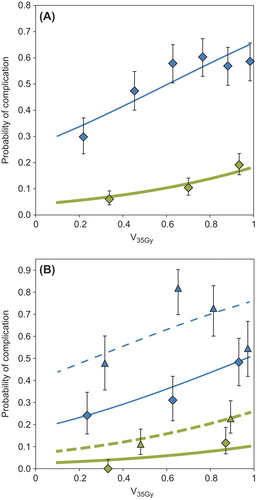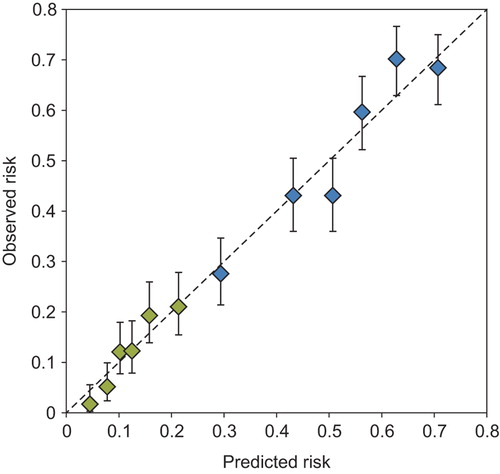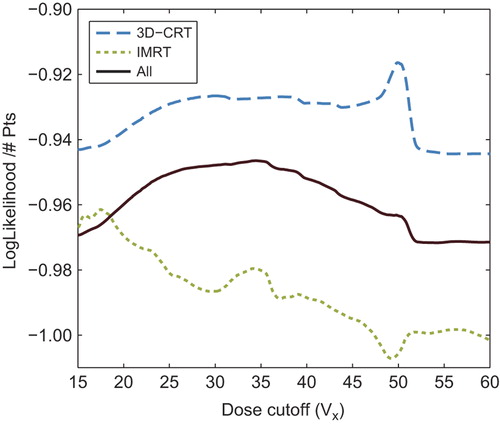Figures & data
Table I. Patient and treatment characteristics.

Table II. Model fit quality for different dose metrics.
Table III. Ordinal logistic model fits for dose cut-off model.


![Figure 4. Optimal dose cut-off model for acute toxicity for patients treated with A) intensity-modulated radiotherapy (IMRT, V18Gy), B) 3D conformal radiotherapy (3D-CRT, V50Gy), and C) the total patient cohort (V35Gy). Figure A) and B) additionally show the observed response for the other patient group [3D-CRT in A) and IMRT in B)]. Figure C) shows observed response for all patients (solid diamonds: 3D-CRT, empty diamonds: IMRT). Thin, blue lines and diamonds: Risk of grade 1 or above acute cystitis. Thick, green lines and diamonds: Risk of grade 2 and above acute cystitis. Uncertainty bars indicate 68% confidence levels.](/cms/asset/f565f910-a136-41db-9198-83b02e1e3bf0/ionc_a_923933_f0004_oc.jpg)
Register now or learn more
Free access



![Figure 4. Optimal dose cut-off model for acute toxicity for patients treated with A) intensity-modulated radiotherapy (IMRT, V18Gy), B) 3D conformal radiotherapy (3D-CRT, V50Gy), and C) the total patient cohort (V35Gy). Figure A) and B) additionally show the observed response for the other patient group [3D-CRT in A) and IMRT in B)]. Figure C) shows observed response for all patients (solid diamonds: 3D-CRT, empty diamonds: IMRT). Thin, blue lines and diamonds: Risk of grade 1 or above acute cystitis. Thick, green lines and diamonds: Risk of grade 2 and above acute cystitis. Uncertainty bars indicate 68% confidence levels.](/cms/asset/f565f910-a136-41db-9198-83b02e1e3bf0/ionc_a_923933_f0004_oc.jpg)
Please note: Selecting permissions does not provide access to the full text of the article, please see our help page How do I view content?
To request a reprint or corporate permissions for this article, please click on the relevant link below:
Please note: Selecting permissions does not provide access to the full text of the article, please see our help page How do I view content?
Obtain permissions instantly via Rightslink by clicking on the button below:
If you are unable to obtain permissions via Rightslink, please complete and submit this Permissions form. For more information, please visit our Permissions help page.
People also read lists articles that other readers of this article have read.
Recommended articles lists articles that we recommend and is powered by our AI driven recommendation engine.
Cited by lists all citing articles based on Crossref citations.
Articles with the Crossref icon will open in a new tab.